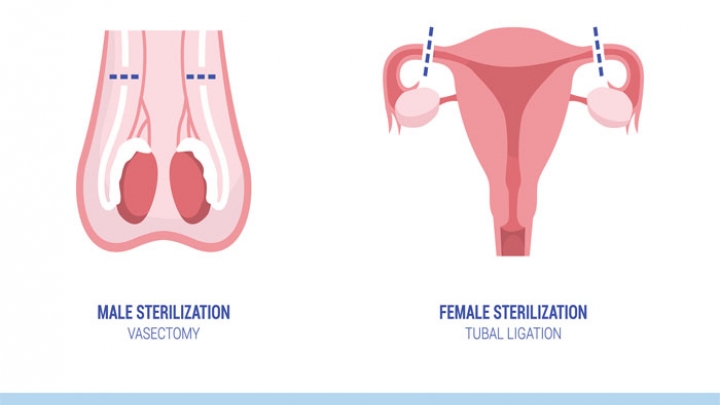(RxWiki News) Learn about sterilization as a permanent form of birth control for women and men.
The choice to have a sterilization procedure is a major decision and should not be made lightly. Sterilization is a permanent form of contraception. Before undergoing sterilization, be sure that you do not want another child or children in the future. For women, tubal ligation is the most common procedure. For men, vasectomy is the most common. Deciding when to proceed can be difficult. Some parents choose to wait until after their last baby’s first birthday to undertake permanent sterilization. Discuss the choices with your care provider1.
Vasectomy2
During the procedure, small openings are made on the right and left sides of the scrotum. The vas deferens on each side is tied, cut, clipped, or closed off. Blocking the vas deferens keeps sperm from traveling from the testicle to the semen. Semen production continues, but it contains no sperm. A female partner’s egg then remains unfertilized. Typical use failure rate: 0.15%.3
- Different instruments and anesthetics can be used. And the vas deferens can be ligated (tied) or cauterized (sealed with heat). Your provider can provide options and recommendations.
- Vasectomy is highly effective at preventing pregnancy. It is even more so than female sterilization.
- It takes two to four months for the semen to become totally free of sperm after the procedure.
- Use another form of birth control until your semen is tested and shown to be clear of sperm.
- Vasectomy is safer and less expensive than female sterilization.
- Major complications are rare.
- Sexual function is not changed by vasectomy.
- Ejaculation and orgasm should feel the same.
- The amount of semen does not decrease by more than 5%.
- Minor risks include minimal bleeding and infection.
- Vasectomy offers no protection against sexually transmitted infections (STIs).
- Attempting to reverse a vasectomy entails microsurgery and is not always successful.
Tubal ligation4
In this procedure, the fallopian tubes are tied, cut, clipped, cauterized, or closed off in various ways. This prevents eggs from moving down the fallopian tube to reach the uterus. It also prevents sperm from moving up the tube to reach an egg. Typical use failure rate: 0.5%.3
- Female sterilization is highly effective at preventing pregnancy.
- Less than 1% of women become pregnant within a year of the procedure.
- In the rare case of pregnancy, the risk of implantation outside of the uterus (ectopic pregnancy) is increased.
- If pregnancy does occur, notify your doctor as soon as possible.
- The risk of ectopic pregnancy is still lower than in women who don’t use birth control.
- Tubal ligation offers no protection against sexually transmitted infections (STIs).
- It does not stop menstruation. You will still have periods.
- It does not impact hormones or bring on menopause.
- Attempting to reverse tubal ligation entails major surgery and is not always successful.
Tubal ligation is usually done in one of two ways:
- Minilaparotomy
- A small incision is made in the abdomen.
- The fallopian tubes are brought up though the opening.
- The entire fallopian tube or a small segment from each is removed and the ends tied off with staples or sutures. Women who have already given birth often choose this procedure.
- Laparoscopy
- A device called a laparoscope is inserted through a small incision near the belly button.
- The procedure is done using instruments passed through the laparoscope.
Fertility preservation
Sterilization is intended to be permanent. Reversing tubal ligation or vasectomy is more difficult than doing the original procedure. It does not always restore the ability to have a child through natural means. To prepare for a possible change of plans, men and women can preserve their fertility prior to sterilization. Procedures for preserving sperm and eggs for later use are standard practice.
For men, the process is easy. They can have semen samples cryopreserved (frozen and stored) before undergoing vasectomy. That leaves the option of fathering another biological child later without undergoing reversal-surgery5.
Women can preserve fertility by having their eggs harvested, frozen, and stored. The process entails hormonal ovarian stimulation, laparoscopic egg retrieval, and freezing and storing the eggs6. As a result, saving eggs for later use is more complex, time consuming, costly, and risky than saving sperm.
If a couple wants to keep the option to have a child after sterilization, vasectomy and sperm preservation may be the better route. A vasectomy is less invasive and requires less downtime than tubal ligation. Moreover, semen collection is easy and inexpensive. It requires no hormonal treatment or surgery7. And the annual fees for freezing and storage are lower for semen than for eggs.
References:
- American College of Obstetricians and Gynecologists
- American College of Obstetricians and Gynecologists
- Contraceptive Technology, 21st Edition. New York, NY: Ayer Company Publishers, Inc., 2018.
- American Urological Association
- European Medical Journal, January 2016.
- American College of Obstetricians and Gynecologists
- Jonathan Fainberg and James A. Kashanian. JAMA, June 2018.

